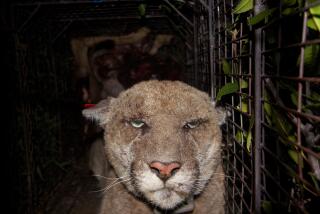Court Lets U.S. Kill Island’s Rats
- Share via
The National Park Service can begin dropping thousands of rat-killing pellets on Anacapa Island as part of a program to save rare seabirds, a federal judge ruled Thursday.
An animal advocacy group had sought to block the $700,000 black rat eradication program in Channel Islands National Park, contending that the poison pellets would harm other wildlife on the three islets that comprise the island off the Ventura County coast.
But in her 30-page ruling, U.S. District Judge Ellen Segal Huvelle concluded that the New York-based Fund for Animals failed to make a convincing case.
The park service’s helicopter drop will begin as soon as the weather clears.
“We consider this a victory for conservation,” said Kate Faulkner, chief of natural resources management for the park. “We felt we’ve done a considerable amount of planning for this project. The science is on our side.”
Michael Markarian, vice president of Fund for Animals, said his lawyers are studying options. “We’re going to see if there is anything else we can do to stop this misguided plan before it goes forward,” he said. “Obviously, time is of the essence.”
But the park service plan has been embraced by conservation groups including the Audubon Society, Ocean Futures, Pacific Seabird Group and the American Bird Conservancy, as well as several state and federal agencies involved in conservation efforts.
By wiping out the rats, an invasive species, scientists hope to protect many components of the island’s ecosystem, including the Xantus’ murrelet, a palm-sized black and white bird that nests on the island.
“All the native plants and animals on Anacapa Island will be better off for the eradication of rats,” Faulkner said. “They are the greatest threat to the survival of seabirds and deer mice.”
Fund for Animals officials had argued there could be corollary damage. Mice that aren’t harming birds could eat the pellets and die, they argued. Birds could eat dead rats and mice and subsequently be poisoned.
“I think the risk of that is very small, and is acceptable given the desperate plight of these seabirds,” said Dan Taylor, executive director of the Audubon Society’s state branch.
To be safe, park service officials will drop the pellets well before the first birds arrive to nest in mid-January. And they are poisoning only the East Anacapa islet this year--which measures about two-tenths of a square mile. They plan to study the effects of the poison on mice, lizards and birds before dropping another round on Middle and West Anacapa next fall.
One pair of black rats can produce 5,000 offspring a year, but scientist say rats on the island frequently starve to death in the winter. Those that survive gobble up birds.
“Our opinion is it’s not a good idea to kill any species, including rats,” Markarian said. “But the basis of our lawsuit was not going into court and saying ‘Don’t kill the rats.’ It was going into court and saying the government is violating environmental laws and policies.”
Rats that eat grain pellets poisoned with the pesticide Brodifacoum usually die within five days from internal bleeding. Faulkner said the death is not thought to be painful, because the rats slowly lose consciousness.
More to Read
Sign up for Essential California
The most important California stories and recommendations in your inbox every morning.
You may occasionally receive promotional content from the Los Angeles Times.










